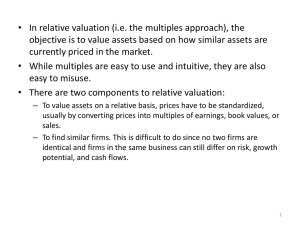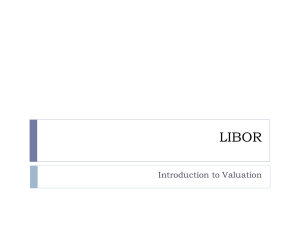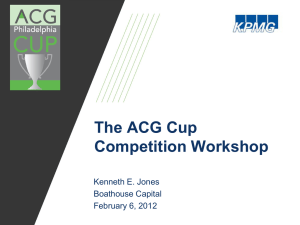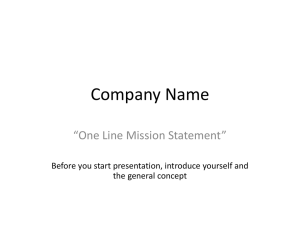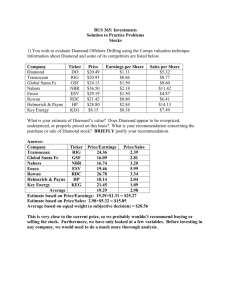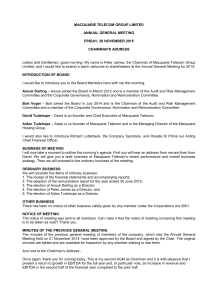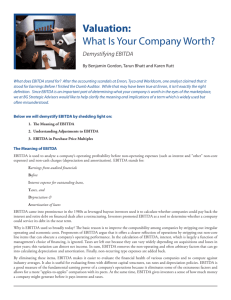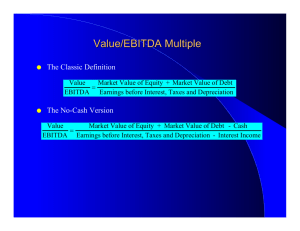Business Valuation 101: Demystifying the Multiple
advertisement
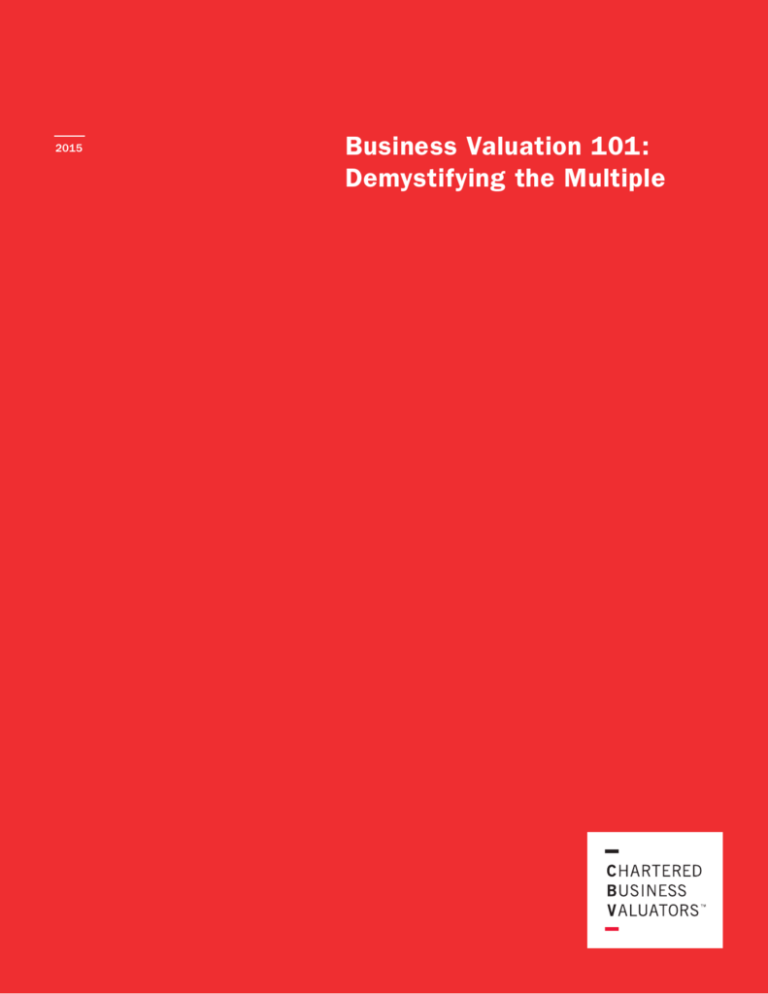
BUSINESS VALUATION 101 2015 Business Valuation 101: Demystifying the Multiple 1 BUSINESS VALUATION 101 2 Business Valuation 101: Demystifying the Multiple When it comes to succession planning for business owners, the two most common questions asked are: “What is my business worth?” and “What is the multiple for my business?” Seemingly simple questions; however in order to get at the answers, one must first define what is meant by “worth” and, secondly, what the “multiple” is being applied to. Some of the most common mistakes made by business owners when quantifying what they think their business is worth involves the application (or misapplication) of the multiple. Another common mistake is underestimating the role of the qualitative factors that go into the selection of an appropriate multiple—the same factors that make a business more or less valuable and sellable. BUSINESS VALUATION 101 3 WHAT IS IT WORTH? RETURN RISK When business owners ask what their business is worth, they are typically referring to the price they can expect if they sold the business. Broadly speaking, price is measured by a specific buyer’s assessment of the company’s risk and return, which is guided by the concept of ‘fair market value’. Fair market value is defined as “the highest price, expressed in terms of money or money’s worth, available in an open and unrestricted market between informed and prudent parties acting at arm’s length and under no compulsion to transact.” MULTIPLE OF WHAT? A business is commonly valued by referencing “a multiple” which is a valuation metric that is determined after considering the market’s perceptions of the risk and expected future growth return inherent in the target business and its industry. The multiple can refer to various metrics (such as a multiple of revenue, EBITDA, after-tax earnings, or cash flows). The appropriate metric is typically a key performance indicator for the target company. Most business owners think in terms of a ‘multiple of earnings’, for example, “I should be able to sell my business for 5 times earnings.” THREE COMMON MISTAKES Three common mistakes when business owners try to quantify the value of their business include: (1) Not using the industry rules of thumb correctly; (2) Applying the right multiple to the wrong metric; and (3) Overlooking the balance sheet. It’s important to use rules of thumb with caution. One size does not fit all. There are rules of thumb that have come to be used in some industries that are based on industry-specific metrics. For example: • • • Internet or social media based companies may use a multiple of clicks, conversions, or users/ unique visitors; Hotels or homecare facilities often use a multiple of the number of rooms or beds; or Insurance agencies will refer to a multiple of annual commission revenue. Rules of thumb for other industries may be based on revenue or profitability metrics. The following is a summary of some of the more commonly used valuation metrics: BUSINESS VALUATION 101 • • • A Price to Earnings (P/E) multiple, which is calculated as a company’s share price divided by the company’s earnings (net income)—this is often quoted for public companies; Enterprise value (EV) to cash flow multiple, which is calculated as the company’s enterprise value (that is, its equity plus debt) divided by its free cash flow (cash flows is EBITDA—defined as ‘earnings before interest, taxes, depreciation and amortization’—minus income tax, capital expenditures and working capital requirements); and EV as a multiple of ‘earnings before interest, taxes, depreciation and amortization’ (EBITDA), which is calculated as the company’s enterprise value divided by its EBITDA. From there, it’s critical to select the right metric to determine the multiple. The most common multiple referenced in private company valuations and transactions is ‘EV to EBITDA’. The other way to think about this multiple is: how many times you multiply EBITDA to equal the company’s EV or how many years of EBITDA determine the company’s EV. The higher the multiple, the higher the resulting value of the company. These valuation metrics are often referred to when pricing businesses, but beware of using rules of thumb incorrectly—e.g. applying the same multiple to all businesses in the industry. No two businesses are exactly alike. A multitude of factors must be considered when selecting the appropriate multiple, including: differing customer base; capital expenditure requirements; debt/equity structures; and growth expectations. More on this later. And, finally, many business owners overlook the role of the balance sheet in determining value. The extent to which a business has too little or too much working capital (relative to the normal level needed to operate the business), an adjustment may be needed to decrease or increase value accordingly. It is also important to understand the impact that debt has on the valuation—this is discussed further in the following section. ENTERPRISE VALUE VS. SHARE (EQUITY) VALUE Commonly misunderstood by business owners, EV (enterprise value) refers to the total value of the company’s shares (equity) and debt. The most common mistakes made by business owners when using a multiple of EBITDA to determine the value of their businesses are: (1) when applying a multiple to the company’s EBITDA, the owner does not use a maintainable level of EBITDA to determine the company’s enterprise value; and (2) after applying the multiple to the company’s maintainable EBITDA, the owner does not subtract the company’s debt to derive the share value. For example, Mr. A was seeking to sell the shares of his business for $4 million. When asked to explain how he derived the value, he indicated that the business was generating $800,000 of EBITDA, and he believed he could sell his business for 5 times EBITDA (or a ‘5 times multiple’). What he forgot was that he was not paying himself a salary to run the business and instead was compensated by having his company declare annual dividends. Further, he did not subtract the company’s debt to derive the share value. Assuming that a ‘5 times multiple’ was correct for his business, the real value of his shares was actually half of what Mr. A calculated. The two adjustments needed to correct Mr. A’s calculation are: 4 BUSINESS VALUATION 101 1) to deduct a fair market salary for somebody to run the business, let’s assume a reasonable salary of $200,000, to derive the adjusted maintainable EBITDA; and 2) to deduct the company’s current debt amount. Here is the calculation: INCORRECT CORRECT EBITDA$800,000 EBITDA $800,000 Multiple5.0x Owner Manager Salary (200,000) Enterprise Value Adjusted EBITDA 600,000 4,000,000 Multiple5.0x Enterprise Value 3,000,000 Less Debt (1,000,000) Share Value 2,000,000 DON’T FORGET THE QUALITATIVE FACTORS EV as a multiple of EBITDA is essentially a measure of risk and reward. A multiple can be higher or lower for a particular business due to the underlying risk associated with the selected cash flow of the business. Some key qualitative factors that are considered in a risk/reward analysis of a company are listed below. Factors that tend to increase the multiple, and increase value: • • • • • A diversified customer base; Long-standing, loyal customers; Long-term contracts signed with key customers; A strong management team. A company with a strong management team that is willing to stay on with the business post-transaction can be worth significantly more than a company without a follow-on management team. Financial buyers, and often, strategic buyers, will place a lot of value in a strong management team. Bigger companies typically transact for higher multiples largely due to reduced risk associated with generating the cash flows of bigger companies. All things being equal, bigger companies typically have a more diversified customer/revenue base, among other advantages. Factors that tend to lower the multiple, and detract from value: • • • • Reliance on a key person(s); Reliance on one or a few key customers; Volatility in earnings; and Low amount of tangible asset backing. 5 BUSINESS VALUATION 101 • Existence of personal goodwill: Personal goodwill exists when a key person (typically the owner-manager) has all (or the majority) of the key relationships with customers, suppliers and employees such that the business would not exist without that person. Often personal goodwill is related to the size of a company—this can detract from the value of a business and could result in a business being unsellable. According to transaction metrics derived from GF Data, (www.gfdataresources.com), enterprise value as a multiple of EBITDA for transactions between 2003 and 2014 averaged as follows: TRANSACTION SIZE $MM EV / EBITDA $10 to $25 5.5x $25 to $50 6.2x $50 to $100 6.7x $100 to $250 7.3x Average6.1x GF Data provides data on private equity-sponsored M&A transactions with enterprise values of $10 to 250 million. GF Data collects transaction information from private equity groups on a blind and confidential basis. As seen in the chart above, the average EV/EBITDA multiple from 2003 to 2014, according to GF Data, was 6.1 times. But, this is just an average. The multiples for a particular company may be higher or lower than this average. The chart below illustrates why a multiple might be higher or lower than the average of 6.1 times EV/ EBITDA as noted above. REASONS WHY TRANSACTION MULTIPLES ARE HIGHER OR LOWER THAN AVERAGE EV / EBITDA MULTIPLES 12.0x Strong Management Strong Brand & Reputation t rs o Repeat/Contractual Revenue Stream ct fa High Asset Values = “Tangible Value” t ha 10.0x 8.0x 6.0x he lp HIGH GROW TH POTENTIAL avg: 6.1x 4.0x 2.0x 0.0x IN CONCLUSION fa ct Low Asset Values Low/Volatile Sales or st ha Low Customer Retention th ur t High Personal Goodwill F L AT OR NEGAT IVE INDUS T RY OU T LOOK Average EV / EBITDA Multiple, EV ≤$250MM 6 BUSINESS VALUATION 101 When business owners are considering successions plans, they need to understand the appropriate multiple to value a business, as each business and industry is unique. Whether buying or selling, an advisor knowledgeable and experienced with determining value and price, like a CBV, will help navigate the complexities of valuation, including determining an appropriate multiple. Having a clear picture of all of the relevant factors brings peace of mind to a business owner that they are making an informed decision about their business. ABOUT THE AUTHOR Craig Maloney, MBA, CA, CBV is a Partner of WBLI Chartered Accountants in Halifax, Nova Scotia. Craig is heavily involved in serving owner-managed businesses and professionals. He specializes in business valuation and providing strategic business advice and corporate finance advice on M&A transactions, and has developed a particular expertise in private company divestitures. Additionally, Craig is the Atlantic representative on the Board of the Canadian Institute of Chartered Business Valuators (CICBV). Office: 902.493.5430 E-mail: cmaloney@wbli.ca 7

